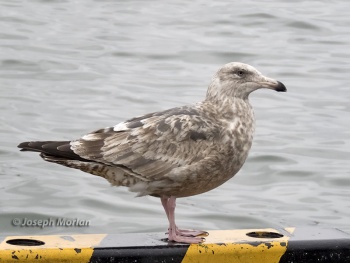- Larus schistisagus
Alternative Names: Kamchatka Gull, Pacific Gull.
Identification
L. 27 inches (68.5 cm)
Breeding Adult
- White head, belly, and tail
- Dark, slaty-gray back and wings
- Broad white trailing edge
- Underside of wings features a "string of pearls" along the edges
- Can be seen from below when the bird is in flight
- Yellow eyes
- Pink legs (appear shorter than similar gulls)
- Body appears stouter than similar gulls
- Yellow bill with orange-red subterminal band
Immature
Highly variable. First cycle mostly brown with brownish wing-tips. May have bleached greater coverts. Second cycle similar but with dark slaty-colored mantle feathers. Third cycle similar to adult but with brown smudging on wing coverts and black spots on otherwise white tail.
Similar Species
The wings and back are slightly darker than those of the Western Gull. Slaty-backed usually shows extended secondaries forming a "skirt." Relatively short primary projection and pot-bellied look. Immature is similar to Great Black-backed Gull, but paler; lacks checkered appearance of that species. Usually distinguished from Herring Gull by brown rather than black wing-tips and relatively plain pattern on greater coverts. May be confused with hybrids between Glaucous-winged Gull and either Herring or Western Gull.
Distribution
It is a common coastal breeding species in northeastern Asia, wintering southward to Japan, Korea and China. Frequently wanders to the western Alaska shorelines. Now annual in northeastern North America with records in many states.
Taxonomy
This is a monotypic species[1].
Habitat
Coastal areas.
Behaviour
Diet
Forager and a scavenger.
References
- Clements, J. F., T. S. Schulenberg, M. J. Iliff, D. Roberson, T. A. Fredericks, B. L. Sullivan, and C. L. Wood. 2018. The eBird/Clements checklist of birds of the world: v2018. Downloaded from http://www.birds.cornell.edu/clementschecklist/download/
- Avianweb
- Burger, J., Gochfeld, M., Garcia, E.F.J. & Kirwan, G.M. (2019). Slaty-backed Gull (Larus schistisagus). In: del Hoyo, J., Elliott, A., Sargatal, J., Christie, D.A. & de Juana, E. (eds.). Handbook of the Birds of the World Alive. Lynx Edicions, Barcelona. (retrieved from https://www.hbw.com/node/53985 on 15 March 2019).
- Howell, S.N.G. & Dunn, J.L. (2007) Gulls of the Americas. Houghton Mifflin, Boston.
- Malling Olsen, K. & Larsson, H. (2003) Gulls of Europe, Asia and North America. Christopher Helm, London.
Recommended Citation
- BirdForum Opus contributors. (2024) Slaty-backed Gull. In: BirdForum, the forum for wild birds and birding. Retrieved 28 April 2024 from https://www.birdforum.net/opus/Slaty-backed_Gull







